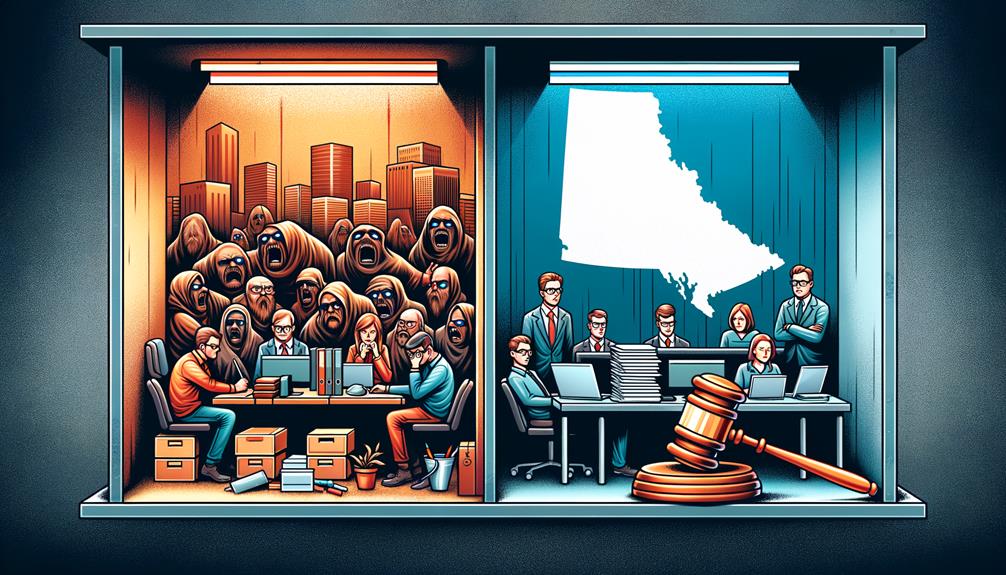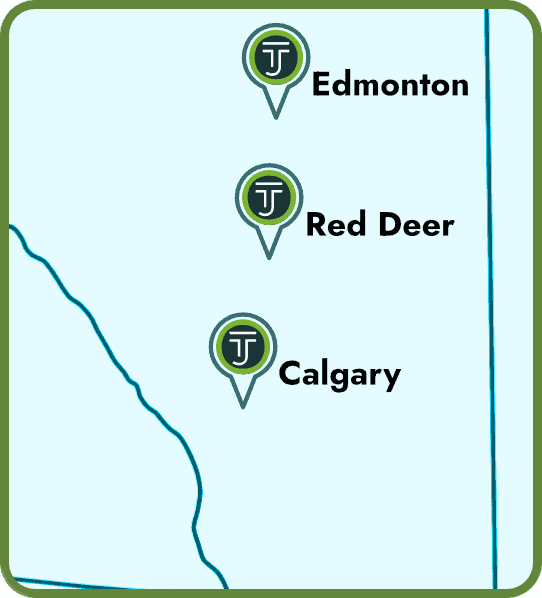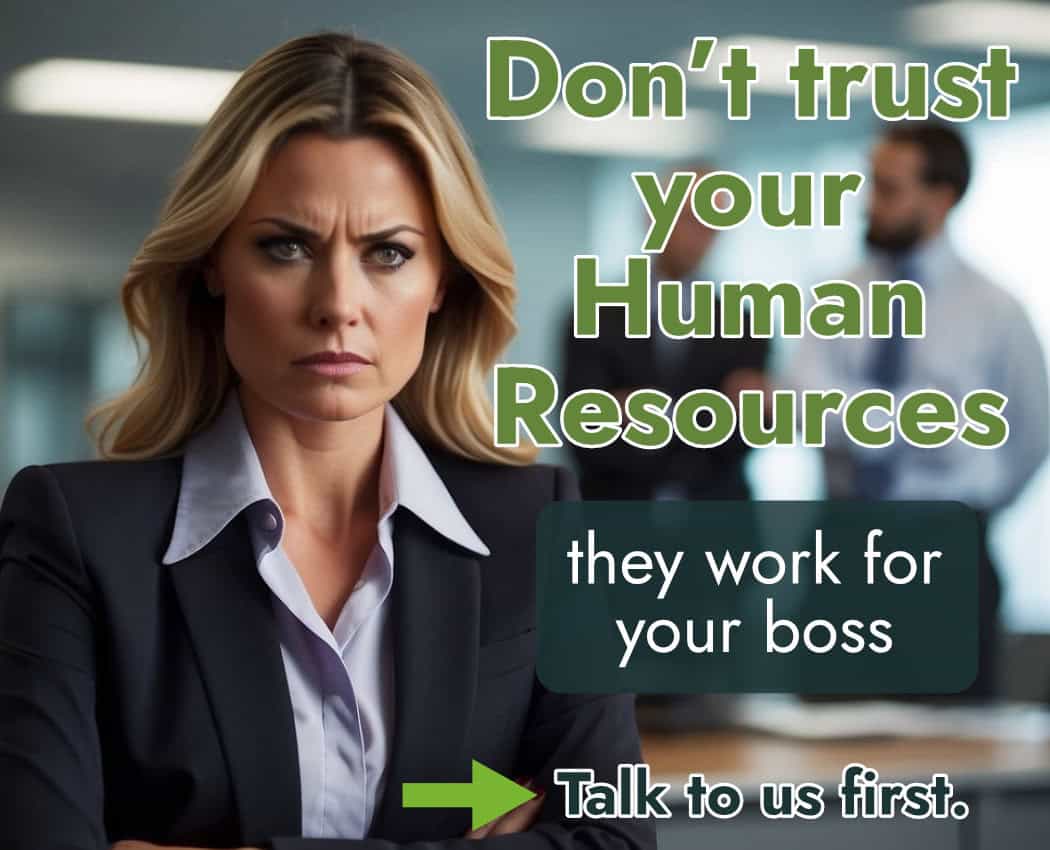
Working in a toxic workplace, which is characterized by ongoing discrimination, harassment, or unreasonable work demands, is not only detrimental to your well-being but also illegal in Alberta. Pursuant to the Alberta Human Rights Act and the Occupational Health and Safety Act, employers are obligated to maintain a safe and respectful work environment. Acts of workplace toxicity can be subjected to legal recourse. If your workplace feels toxic, consider approaching your human resources representative or seek professional legal advice. Understand that there are options and strategies available to protect your rights, maintain your health, and improve your work environment.
Key Takeaways
- In Alberta, a toxic workplace may involve harassment or discrimination, which is illegal under the Alberta Human Rights Act.
- The Act protects against harassment based on race, gender, age, and other protected grounds occurring in the workplace.
- Employers are obligated to implement harassment prevention policies aligned with the Act, ensuring a safe and inclusive work environment.
- If you’re experiencing harassment, it’s important to document incidents and report them to your HR or supervisor.
- If the harassment continues or you face retaliation for reporting, you may need to seek legal counsel to understand your rights.
Signs of a Toxic Workplace
While it may not always be immediately apparent, there are several telltale signs that can indicate a toxic workplace; these can range from a pervasive atmosphere of gossip and rumours, to the presence of narcissistic leadership and the application of unsustainable workloads. When employees feel unheard or ignored, this can lead to disengagement and a decrease in productivity. A culture of gossip and rumours can breed mistrust and uncertainty, making it difficult to maintain open lines of communication or to discuss sensitive issues such as mental health concerns.
In some cases, employees may experience bullying, which can take both overt and covert forms. This type of behaviour is not only harmful to the victim but can also negatively impact the overall workplace environment. Favouritism, where rules appear to apply to some but not all employees, can foster resentment and lower morale.
Leaders who are self-interested and lack empathy can create a hostile environment where employees feel undervalued and unappreciated. Finally, unsustainable workloads can lead to burnout and mental health issues, further exacerbating the toxic atmosphere. Recognizing these signs is essential in identifying and addressing workplace toxicity.
Types of Workplace Harassment
In the domain of professional environments, workplace harassment can manifest in a variety of forms, each with its own potentially detrimental impact on employees and the organization as a whole. Chiefly, these can be classified into several categories.
Sexual harassment is one of the most recognized forms involving unwelcome sexual advances, requests for sexual favors, or other verbal or physical conduct of a sexual nature. Discrimination, another prevalent form, involves unfair treatment based on race, gender, age, religion, or other protected characteristics.
Workplace bullying, characterized by persistent offensive, intimidating, or humiliating behavior, is another form of harassment. This could range from verbal abuse and threats to spreading malicious rumours or undermining someone’s work.
Retaliation against whistleblowers who expose wrongful acts within the organization is also considered a form of harassment. This can be in the form of unjust punishment, demotion, or dismissal. Finally, microaggressions, which are subtle, often unconscious, expressions of prejudice or bias, constitute a more insidious form of harassment. Understanding these types is the first step in addressing and preventing workplace harassment.
Impact of Workplace Harassment
The detrimental effects of workplace harassment permeate both individual employees and the organization as a whole, resulting in several significant consequences. On a personal level, victims often suffer from psychological distress, including anxiety, depression, and low self-esteem. This can lead to increased absenteeism, decreased productivity, and in severe cases, individuals leaving the workforce entirely.
The organization, on the other hand, experiences the repercussions of a hostile work environment. High turnover rates, lower productivity, and increased sick leaves are common symptoms of a workplace fraught with harassment. This not only results in financial losses due to recruitment costs and lost productivity but also tarnishes the company’s reputation, making it challenging to attract top talent.
Moreover, workplace harassment can result in legal repercussions. In Alberta, employers can be held liable for failing to address harassment, leading to potential lawsuits and hefty fines. The turbulent work environment also distracts from the organization’s goals and hampers growth in the long run. The impact of workplace harassment extends beyond personal distress to economics, reputation, and legal standing, making it a critical concern for both employees and employers.
Reporting and Addressing Harassment
Getting through a toxic work environment can be challenging, but knowing how to report and address harassment is an essential step toward resolution. In Alberta, it is important to be aware of your company’s policies and procedures on harassment and follow these carefully.
Documentation is a key aspect of reporting harassment. Make sure to record all incidents detailing what happened, when, where, and who was involved. This will provide concrete evidence if you choose to escalate the situation.
Reporting harassment to your Human Resources department or a supervisor should be your next step. Your company should have a procedure in place to handle these reports seriously and confidentially. If the harassment continues, it is advisable to seek support from colleagues, a counsellor, or a professional organization that can provide advice and guidance.
Preventing Workplace Harassment
While maintaining a toxic work environment can be challenging, establishing effective strategies to prevent workplace harassment is crucial for fostering a healthier, more productive work atmosphere. This involves a proactive approach from both employers and employees to create a culture of respect and inclusivity.
In Alberta, the law mandates employers to guarantee a safe and respectful work environment. Here are a few strategies that can be employed:
- Regulate and Implement Policies: Employers should have clear policies against harassment and ensure all employees are familiar with them.
- Training Programs: Regular training on harassment prevention and human rights can help employees understand what constitutes harassment and how to respond.
- Open Communication Channels: Encourage employees to speak up about any issues without fear of retaliation.
- Accountability: Employers need to hold the perpetrators of harassment accountable and take immediate action against reported incidents.
Understanding Harassment at Work
Understanding harassment at work plays a pivotal role in maintaining a respectful and inclusive work environment. Harassment, simply put, is any unwanted conduct that creates an intimidating, hostile, or offensive environment. It can manifest in different forms, ranging from physical, verbal, or psychological, and can be perpetrated by anyone in the workplace, including supervisors, colleagues, or clients.
In Alberta, harassment is viewed seriously and is legislated under the Occupational Health and Safety Act. It includes behaviours such as offensive jokes, slurs, physical assaults or threats, intimidation, ridicule, insults, or put-downs. Moreover, harassment becomes discrimination when it is based on protected grounds, such as race, gender, religion, age, or disability.
It’s important to note that harassment isn’t limited to overt actions. Subtle forms, known as microaggressions, are equally damaging. These are indirect, subtle, or unintentional acts of discrimination against members of a marginalized group.
Understanding harassment at work is the first step toward fostering a respectful and inclusive work environment. It empowers employees to recognize inappropriate behaviour, affirms their rights, and take appropriate action.
Dealing With Harassment at Work
Mastering the intricate landscape of workplace harassment necessitates a fundamental understanding of its various forms, the courage to confront it, and knowledge of the appropriate channels for reporting such incidents. Harassment includes verbal, non-verbal, and physical actions which may cause discomfort, fear, or distress to the victim. In Alberta, workplace harassment is not only morally unacceptable, but it also infringes upon the Alberta Human Rights Act and the Occupational Health and Safety Act.
When dealing with harassment, it’s essential to:
- Identify the behaviour: Understand what constitutes harassment, and be vigilant of any such behaviour in your surroundings.
- Document incidents: Maintain a record of each incident, including date, time, place, and any witnesses. This will be valuable when reporting the harassment.
- Report to the appropriate authority: Follow your organization’s procedure for reporting harassment. If your company lacks such a procedure, report to a supervisor or Human Resources.
- Seek legal advice: If the harassment continues or if you face retaliation for reporting, you might need to seek legal counsel to understand your rights and possible courses of action.
Toxic Workplace FAQ
In light of understanding how to deal with harassment at work, it is equally important to address some commonly asked questions related to toxic workplaces in Alberta.
Firstly, not all hate, racism, harassment, or bullying is considered discrimination under the Alberta Human Rights Act. It must be based on protected grounds, occur in protected areas, and lead to negative effects to qualify as discrimination.
Sexual harassment, a form of discrimination, is unwelcome behaviour based on gender and can range from subtle to serious forms. The Canadian Criminal Code defines criminal harassment as repeated unwanted actions causing fear for safety.
A harassment prevention policy, implemented by organizations, addresses harassment internally aligning with the Alberta Human Rights Act. These policies typically include definitions, roles, complaint processes, and disciplinary actions.
Employers are responsible for harassment in the workplace and should promptly address such issues. Implementing and enforcing harassment prevention policies, educating employees, and fostering a respectful work culture are essential steps to prevent harassment.
Conclusion
The prevalence of toxic workplaces in Alberta emphasizes the importance of understanding and addressing workplace harassment.
It’s essential to identify signs of toxicity, comprehend different types of harassment, and know how to report incidents.
Employers bear a significant responsibility in preventing harassment and fostering a respectful environment.
The existing laws in Alberta provide some protection, but continuous efforts are necessary to eradicate workplace toxicity, ensuring a safe and productive work environment for all employees.
References
Alberta Human Rights Act, RSA 2000, c A-25.5
https://www.canlii.org/en/ab/laws/stat/rsa-2000-c-a-25.5/212863/rsa-2000-c-a-25.5.html
Occupational Health and Safety Act, SA 2020, c O-2.2
https://www.canlii.org/en/ab/laws/stat/sa-2020-c-o-2.2/217173/sa-2020-c-o-2.2.html
Criminal Code, RSC 1985, c C-46
https://www.canlii.org/en/ca/laws/stat/rsc-1985-c-c-46/217670/rsc-1985-c-c-46.html

We currently have three offices across Alberta — Edmonton, Calgary, and Red Deer. We serve the entire province of Alberta (and BC). We also have the infrastructure to work with any of our clients virtually — even the furthest regions of Alberta.
Call 1 (844) 224-0222 (toll free) to get routed to the best office for you or contact us online for general inquiries.
We also have a dedicated intake form to help you get the ball rolling. Our intake team will review your specific case and advise you on the next steps to take as well as what to expect moving forward.
Our offices are generally open 8:30 a.m.—4:30 p.m., Mon—Fri.


Heather Gagnier
WORKPLACE LAWYER
Heather is a lawyer in the firm’s Edmonton office. Her practice primarily focuses on workplace matters, including wrongful dismissals, severance review, workplace harassment, human rights issues and discrimination, non-competition and non-solicitation agreements.
PRIVACY NOTICE: Any information you provide to our office — whether your personal information or employment/employer details — will be treated as strictly confidential and will not be disclosed to your employer or to any other third party. So, please be reassured that you can talk openly to our capable Intake Paralegals worry free. Fill out an Online Inquiry or call us now, your information will be in safe and helping hands.
The Legal Review Process by Taylor Janis Workplace Law
- Taylor Janis strives for high-quality, legally verified content.
- Content is meticulously researched and reviewed by our legal writers/proofers.
- Details are sourced from trusted legal sources like the Employment Standards Code.
- Each article is edited for accuracy, clarity, and relevance.
- If you find any incorrect information or discrepancies in legal facts, we kindly ask that you contact us with a correction to ensure accuracy.


